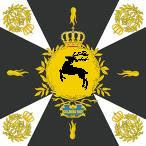As another battle is no doubt in the offing, it’s probably wise to take stock of the strategic situation. The Feldmarschall von Krumper has led his (surviving) loyal Aschenbachers southwards, which was probably a good move for him. Fighting a battle outside the capital of Flussburg would have likely seen him meet with disaster, and ended the campaign. Moving south and closer to his supply depot also rendered the efforts of the Luftberg hussars quite fruitless, as they could no longer raid his supply carts as they trundled along a single viable road. As the Luftberg army devoted several weeks to marching on Flussburg and starting it’s siege, the delay gave von Krumper some time to ponder his next move without a pursuit on his back.
Sitting tight in the central southern region, von Krumper dug in and created a good defensive position for himself, one decent march away from the bridges across the Rhine. Cutting supply lines was, by this point, the only decent way of causing attrition losses to either side. Aschenbach was always poor at raiding, but now Luftberg’s armies are significantly degraded at it – virtually all of their losses in horses have been taken out of the poor hussars, so remounts could keep the battlefield cavalry at top strength.
As the siege dragged on, the isolated detatchment under General van der Dijk became more and more of a tempting target. Not able to quickly move his infantry, von Krumper decided on a raiding force consisting of the Aschenbach army’s cavalry – under General von Kleintrink – to hit them out of the blue. I initially intended this to be a straightforward cavalry skirmish battle, but the remaining Luftberg hussars proved to be so weak that it would have been impossibly one-sided. Using the M&R campaign rules to resolve minor skirmishes, the remaining hussars were scattered (van der Dijk rolled to see what his fate was, and managed to escape – curses!)
The Luftberg army has so far remained in one big formation, but it looks that will now have to change. Sitting tight in one mass at Flussburg is risky, as the river crossings would then be undefended and disastrous losses would follow as the Aschenbach army cut the supply lines. Likewise, abandoning the siege is impossible at this point as the campaign is half-over, so breaking it off and resuming later would probably be too late to secure the capital. The best option (or rather, the least-bad option) is to move the main army back to a central position and wait, leaving as small a force as possible to continue the siege. This lets the Luftberg army play to it’s main strength, which is that it can be on the defensive. Although it’s their invasion they are now strategically in a defensive posture. They have bagged a field victory (one of three objectives,) hold the river crossings (two of three objectives,) and will soon have the besieged capital in their hands (three of three objectives – handing them a major victory!)
Aschenbach have indeed got to do all the running now. With this, von Krumper has now hit upon an idea – or rather, I was reminded of this as I flipped through the rulebook one evening – a forced march. Quickly perceiving the siege was coming to an end as an attempted assault failed, von Krumper marched his men to exhaustion to descend on the besieging force, catching it before it could disengage. The battle at Flussburg is about to begin…
Subscribe to:
Post Comments (Atom)


No comments:
Post a Comment